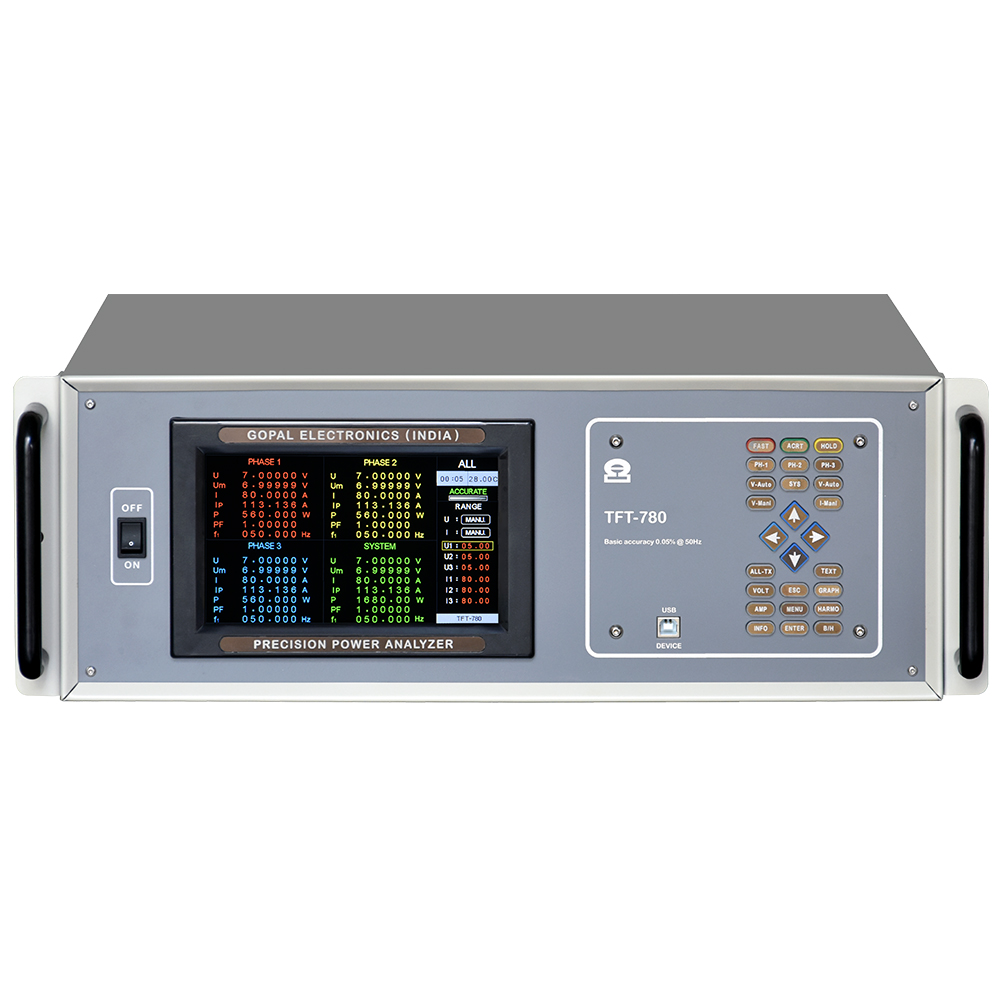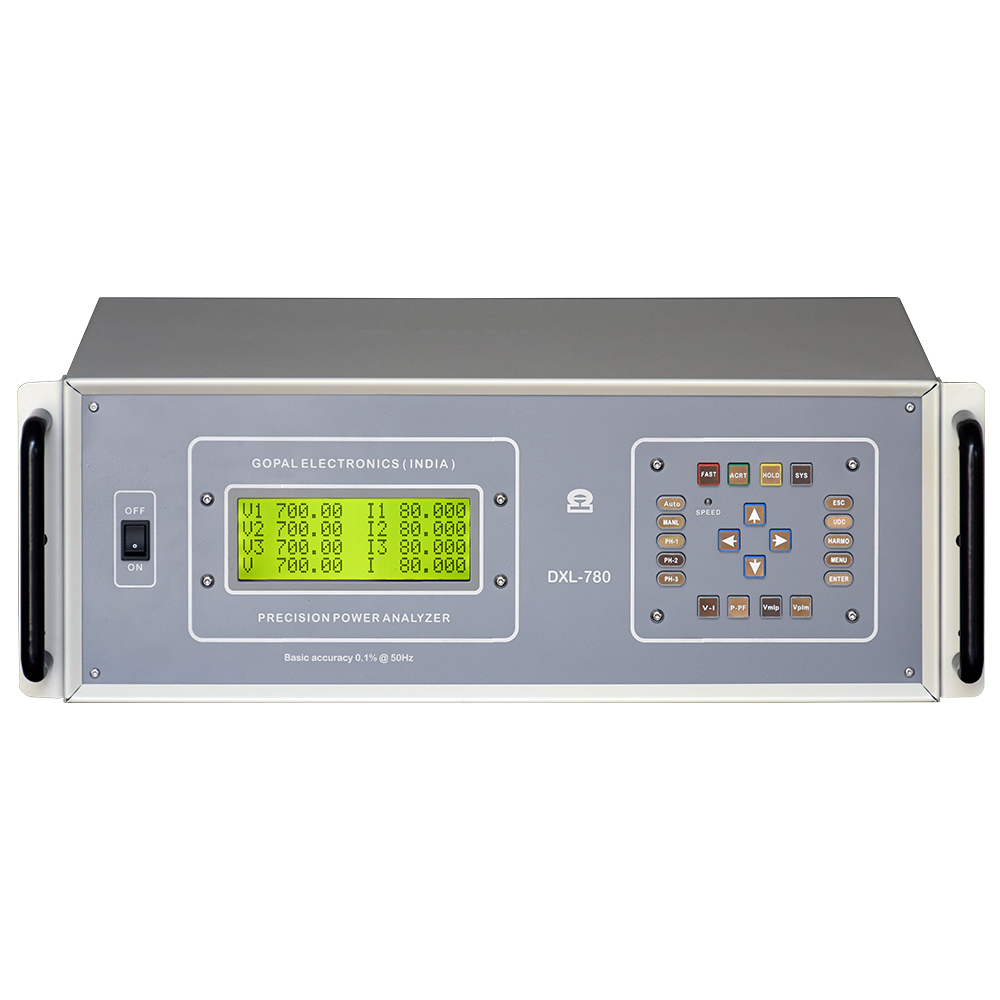Description
Introducing the 3 Phase Power Analyzer LCD780 :
3 Phase Power Analyzer LCD780 is multi-range power Analyzer with basic 0.07% R+R accuracy. 8 range of voltage, 8 range of current and total 64 range of power and power factor gives more accurate result. The gap less four-quadrant power measurement technique gives better accuracy.
3 Phase Power Analyzer LCD80 provides facility to selection speed of measurement by keypad. It play big role during setting test voltage and current in transformer testing. User can set fast speed mode during setting of test voltage and current and then accurate mode during fine measurement. It saves time in make testing easy. Three key provided as Fast, Accurate & hold. Fast refers to fast measurement speed. Accurate for precise measurement while taking the reading. Hold is to freeze the value on screen to easily take the results.
Features of 3 Phase Power Analyzer LCD780 :
3 Phase power analyzer LCD780 comes with USB 2.0 connectivity along with free software tool. Where user can view all parameter in single display and generate test report. More over real time recording facility also given in software for monitoring application. Software is capable to change the range and set the CT/PT scale in the instrument. So while using software user not require to touch the instrument by any way. Software is suitable for latest windows 10 and 64bit operation
3 phase power analyzer LCD780 has harmonics measurement inbuilt. So user can check the harmonics of voltage or current upto 31th element. And also displays Total harmonics distortion THD value on the screen.
3 phase power analyzer LCD780 is used for transformer testing, motor testing or any other electrical appliance testing. It is trusted by more than 3000+ customers all over the world. And we have state of the art manufacturing facility including inhouse fabrication and calibration lab.
3 phase power analyzer LCD780 is inbuilt memory to save the test results and later user can transfer it to excel by using software
check product Demo on : Our Youtube Channel
-
Multi Range
Multi range offers linear accuracy while testing small to big size transformer. Specially beneficial when using external CT/PT
-
Harmonics
Harmonics measurement up to 64th element can be measure
-
Software
LCD780 model comes with standard computer software to easily create report and use equipment by PC
Application Note
Any testing equipment defines it’s accuracy at full scale value. for example a volt meter of 1000V range with 0.1% accuracy can achieve 0.1% accuracy at 1000V not at 1V. If you measure 1V in that volt meter it can give tremendous error. 0.1% error of 1000v is 1V. It means when you are measuring 1v in such volt meter can show you reading 0V or 2V means it has 100% error.
Multi range equipment is more beneficial and highly accurate for their entire measuring range. So user can achieve linear accuracy from milli volt to 1000V. So in multi range equipment user will be able to test small transformer like 100VA to big transformer like 10MVA
Harmonics measurement in transformer testing is important for several reasons:
Quality of Power Supply: Transformers are vital components in power distribution systems. Harmonics in the power supply can be generated by non-linear loads such as computers, variable speed drives, and other electronic equipment. These harmonics can affect the quality of the power supply and, in turn, impact the performance and efficiency of transformers.
Overheating and Losses: Harmonics can cause additional losses in transformers, leading to overheating. Transformers are designed to operate efficiently with sinusoidal voltages and currents. When non-sinusoidal waveforms with harmonics are present, they can cause increased eddy current and hysteresis losses in the transformer’s core, leading to higher temperatures.
Transformer Design and Sizing: Harmonics can affect the design and sizing of transformers. Excessive harmonics may require transformers to be oversized to handle the additional losses and heating caused by non-sinusoidal waveforms. Properly understanding the harmonic content helps in designing transformers that can operate effectively under real-world conditions.
Compliance with Standards: Various international standards, such as IEEE standards, set limits on the acceptable levels of harmonics in power systems. Harmonics measurement in transformer testing ensures that the transformers comply with these standards and operate within acceptable limits.
Diagnostic Tool: Harmonic analysis can serve as a diagnostic tool to identify problems in the power system. Unusual harmonic patterns can indicate issues with connected loads or other components in the system. By monitoring harmonics, maintenance and troubleshooting efforts can be more targeted and efficient.
Power Quality Analysis:Power analyzers can assess the quality of the electrical power supplied to a transformer. They monitor parameters such as voltage, current, power factor, and harmonics to identify any deviations from the ideal sinusoidal waveform.
Power quality analysis helps in ensuring that the transformer operates under optimal conditions and is not subjected to abnormal voltage or current fluctuations.
Efficiency Testing:Power analyzers are used to measure the input and output power of transformers. By comparing these values, the efficiency of the transformer can be calculated. This is essential for evaluating the performance and energy efficiency of the transformer under various load conditions.
Load Profiling:Power analyzers help in creating load profiles by monitoring the transformer’s electrical parameters over time. This information is valuable for understanding the transformer’s behavior under different load conditions, which aids in optimizing its operation and preventing overloading.
Harmonic Analysis:Power analyzers can measure harmonics in the electrical system. Transformers are sensitive to harmonics, and excessive harmonic content can lead to increased losses and reduced efficiency.
Harmonic analysis using power analyzers helps in identifying and mitigating harmonic issues to prevent transformer overheating and other related problems.
Transformer Losses Measurement:Power analyzers quantify losses in transformers by measuring the input and output power. This includes both copper losses (I²R losses) and core losses.
Accurate measurement of losses is essential for assessing the overall efficiency and performance of the transformer.
Voltage and Current
Monitoring:Power analyzers continuously monitor the voltage and current levels in the transformer. Any deviations from the specified values can be quickly identified, allowing for prompt corrective actions to be taken.





Reviews
There are no reviews yet.